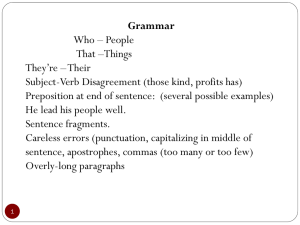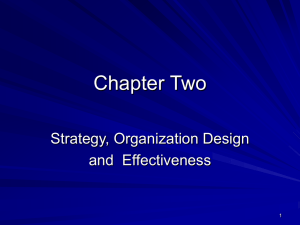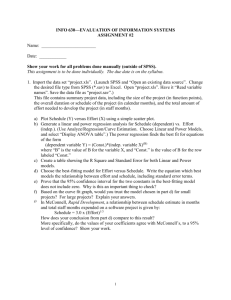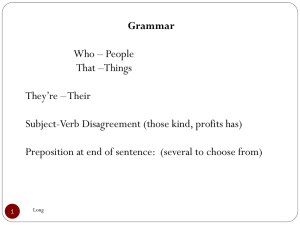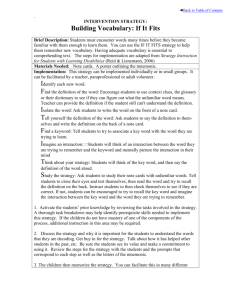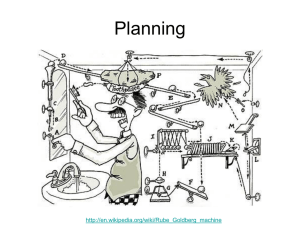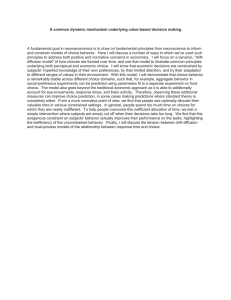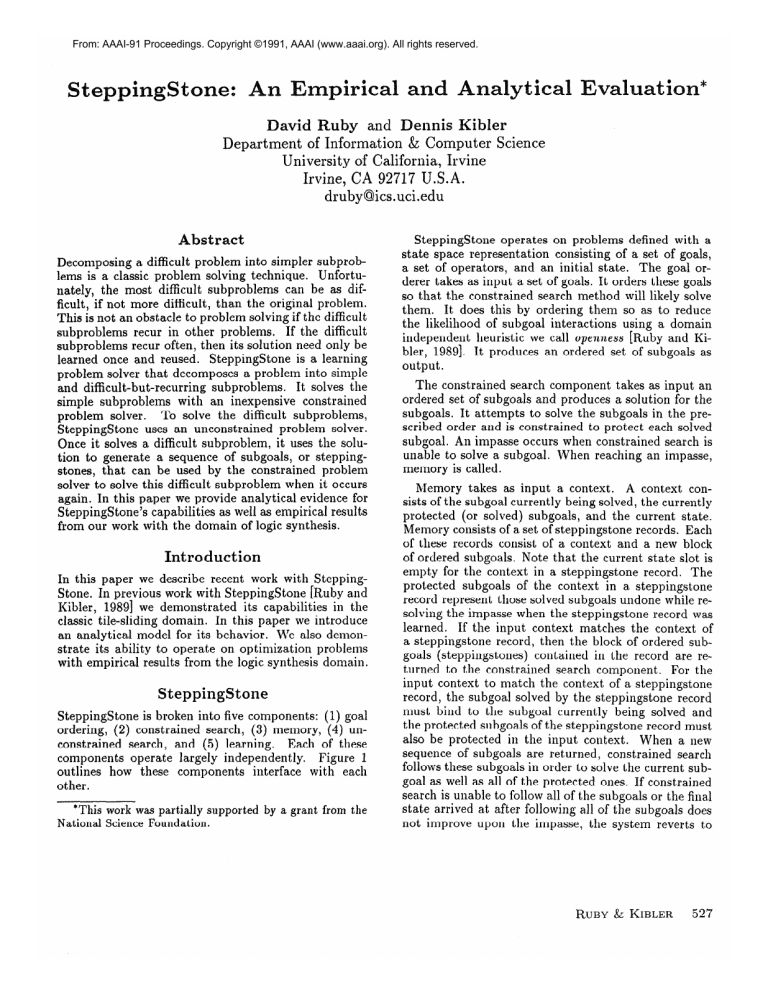
From: AAAI-91 Proceedings. Copyright ©1991, AAAI (www.aaai.org). All rights reserved.
irid
pingStone:
an
nalyt ica
David Ruby and Dennis Kibler
Department of Information & Computer
University of California, Irvine
Irvine, CA 92717 U.S.A.
druby@ics.uci.edu
Abstract
Decomposing
a difficult problem into simpler subproblems is a classic problem solving technique.
Unfortunately, the most difficult subproblems
can be as difficult, if not more difficult, than the original problem.
This is not an obstacle to problem solving if the difficult
subproblems
recur in other problems.
If the difficult
subproblems
recur often, then its solution need only be
learned once and reused.
Steppingstone
is a learning
problem solver that decomposes a problem into simple
and difficult-but-recurring
subproblems.
It solves the
simple subproblems
with an inexpensive
constrained
To solve the difficult subproblems,
problem solver.
Steppingstone
uses an unconstrained
problem solver.
Once it solves a difficult subproblem,
it uses the solution to generate a sequence of subgoals,
or steppingstones, that can be used by the constrained
problem
solver to solve this difficult subproblem
when it occurs
again. In this paper we provide analytical
evidence for
Steppingstone’s
capabilities
as well as empirical results
from our work with the domain of logic synthesis.
Introduction
In this paper we describe recent work with SteppingStone. 111previous work with Steppingstone
[Ruby and
its capabilities
in the
Kibler, 19891 we demonstrated
classic tile-sliding
domain.
In this paper we introduce
an analytical
model for its behavior.
W’e also demonstrate its ability to operate on optimization
problems
with empirical results from the logic synthesis domain.
SteppingStone
Steppingstone
is broken into five components:
(1) goal
search, (3) memory, (4) unordering,
(2) constrained
constrained
search, and (5) learning.
Each of these
components
operate largely independently.
Figure 1
outlines
how these components
interface
with each
other.
*This work was partially supported
National Science Foundation.
by a grant from the
Science
SteppingStone
operates on problems defined with a
state space representation
consisting of a set of goals,
a set of operators,
and an initial state.
The goal orderer takes as input a set of goals. It orders these goals
so that the constrained
search method will likely solve
them.
It does this by ordering them so as to reduce
the likelihood of subgoal interactions
using a domain
independent
heuristic we call opellltess [Ruby and Kibler, 19891. It produces an ordered set of subgoals as
output.
The constrained
search component
takes as input an
ordered set of subgoals and produces a solution for the
subgoals. It attempts
to solve the subgoals in the prescribed order and is constrained
to protect each solved
subgoal. An impasse occurs when constrained
search is
unable to solve a subgoal. When reaching an impasse,
memory is called.
Memory takes as input a context.
A context consists of the subgoal currently being solved, the currently
protected
(or solved) subgoals, and the current state.
Memory consists of a set of steppingstone
records. Each
of these records consist of a context and a new block
of ordered subgoals. Note that the current state slot is
empty for the context in a steppingstone
record. The
protected
subgoals of the context in a steppingstone
record represent those solved subgoals undone while resolving the impasse when the steppingstone
record was
learned.
If the input context matches the context of
a steppingstone
record, then the block of ordered subgoals (steppingstones)
contained
in the record are returned to the constrained
search component.
For t,he
input context to match the context of a steppingstone
record, the subgoal solved by the steppingstone
record
must bind to the subgoal currently
being solved and
the protected subgoals of the steppingstone
record must
also be protected
in the input context.
When a new
sequence of subgoals are returned,
constrained
search
follows these subgoals in order to solve the current subgoal as well as all of the protected ones. If constrained
search is unable to follow all of the subgoals or the final
state arrived at after following all of the subgoals does
the impa.sse, the system reverts to
not improve upon
RUBY & KIBLER
527
A Set of Goals
Solution
Figure
1: Overview
the original impasse state.
When memory fails to return any useful steppingstones the constrained
search component
calls the unThe unconstrained
constrained
search component.
search component
takes as input a context, just as the
memory component
did. Unconstrained
search relaxes
the protection
on the solved subgoals in its search for
a solution.
If it resolves the impasse, it returns the sequence of moves found to the constrained
search component. The unconstrained
search component
also sends
along with the context,
to the
its impasse solution,
learner.
The learner takes as input a context and a solution. It
uses the context to aid in generalizing
over the sequence
of moves making up the solution to generate a new block
of ordered subgoals.
These ordered subgoals are then
passed to memory for reuse on other problems.
We’ll
now examine these components
in more detail.
Steppingstones
as Plans
SteppingStone
learns plans for solving recurring
subproblems.
Steppingstone
represents
its plans as sequences of subgoals (steppingstones)
for resolving an
A sequence of subgoals
consists of an orimpasse.
dered set of partial state descriptions
(subgoals).
The
constrained
problem solver uses these subgoals as steppingstones
to lea.d\it through the impasse. These steppingstones
are indexed by the subgoal they reduce a.nd
the previously solved subgoals that are undone and resolved. After following a sequence of subgoals, any previously solved subgoals remain solved and the subgoal
difference generating
the impasse is reduced.
Figure 2 gives an example of a sequence of subgoals
for solving an impasse from the $-puzzle domain.
For
one of these subgoals to be true in a state the tiles listed
in the subgoal must be in the same position as they are
in the state. The blank squares in these subgoals are allowed to match any tile. The subgoal sequence provides
a method for correctly placing the 3-tile when the l-tile
and 2-tile have already been correctly placed.
These
subgoals can be followed by the constrained
problem
solver to lead to a state where the l-tile, a-tile and
S-tile are all correctly placed.
Note the blank is not
528
LEARNING SEARCH CONTROL
of Steppingstone
Figure
2: Steppingstones
from Memory
included in any of t’he subgoals because it was not protected when the subgoal sequence was learned
Steppingstones
as a representation
of a plan differ in
several ways from macro-operators
[Laird et al., 19871.
Wit,11 macro-operators
it can be difficult to represent
some types of generalizations.
For example,
the sequence of operations
needed to move from the first subgoal in Figure 2 to the last one will be dependent
upon
where the blank is initially.
Any reuse of a plan for
this solution based on operations
will also be dependent upon the position of the blank. The sequence of
subgoals provided is independent
of the blank.
Steppingstones
allow for the use of heuristic generalization while still guaranteeing
that any state generated is a legal state. This is not possible with macrooperators.
If new macro-operators
are ever learned that
produce results not originally
possible with the initial
domain operators,
an illegal state might be produced.
This limits the types of generalizations
that can be allowed with macros.
Steppingstones
do not have this
limitation.
Since they can only be used if they can be
followed using the initial set of domain operators, they
can be overgeneral
and still guarantee
that any state
generated is legal.
Steppingstones
pay for their increased expressiveness
with a higher application
cost. Steppingstones
must be
instantiated
with search. Steppingstones
demonstrate
how search can be used to compensate
for representation limitations
of a given formulation
of a domain.
Learning New Steppingstones
If the system has no knowledge concerning
how to resolve an impasse, Steppingstone
resorts to its unconsearch
strained
problem
solver, localized brute-force
[Ruby and Kibler, 19891. Once a sequence of moves
for resolving a.n impasse is found, the learner generalizes it to derive a new subgoal sequence. The first step
in this process is to translate
the sequence of moves to
the sequence of states generated by the moves. This sequence of states can be regarded as a sequence of very
specific subgoals. Since these subgoals solve an impasse,
we assume that only those portions of the state involved
in the impasse context are relevant.
Here, the impasse
context includes the protected
subgoals that were undone and the subgoal that was being solved. This allows the subgoals to be generalized by including in each
subgoal only those portions of the state involved with
the subgoal being solved and the protected
subgoals
that needed to be undone to solve the impasse.
The
removed portion of the state is variablized.
For the esa.mple subgoals given in Figure 2, tile-l and tile-2 are
the portions of the state involved with previously solved
subgoals.
Tile-3 is the part of the state involved with
the subgoal being solved. The rest of the stat(e is va.riablized and allowed to match anything.
Only the moves used to resolve an impasse and the
impasse context are used to generate the new steppingstones. This allows any method for finding the moves
to resolve an impasse to be used to generate new steppingstones.
Steppingstone
can use an impasse solution
provided by a.n expert as ea.sily as the system uses the
results of its brute-force
search procedure.
Analytic Models
In this section we present an analysis of the effectiveness
of the Steppingstone
approach.
In order to perform
this analysis, we will make strong assumptions
about
the domain and the problem solving process. In particular we will model the problem solvers in SteppingStone
as bounded breadth-first
search or hill-climbing
search.
The goal of this analysis is to a.nalytically
eva.luate the
value of memory in SteppingStone.
In our analysis we
will compare two situations:
SteppingStone
with no
memory and Steppingstone
with a complete memory.
Breadth-First
Model
In both of our models, we assume that the branching
factor is the consta.nt b. In our first model, we assume
that the constrained
problem solver does a breadth first,
search to depth cl and the unconstrained
problem solver
does a search to depth L * d, where k > 1. We also a.ssume that SteppingStone
can solve all problems without
the use of memory.
Before any learning takes pla.ce, St,eppingStone
will
oscillate between two search processes defined by the
constrained
and unconstrained
problem solving process.
Suppose the constrained
problem solver is called c times
while the unconstra.ined
one is called u times. Then the
total computation
cost for a memoryless SteppingStone
is bounded above by:
(c + u) * bd + u * bk*t
(1)
Now suppose that sufficient learning takes place such
that the unconstrained
problem solver need never be
called. We define b, as the number of steppingstone
sequences that will match an impasse and assume that
it is the same for all impasses.
Since all but the last
of the steppingstones
that match might fail to resolve
the impasse, to resolve an impasse might require trying
every steppingstone
that matches. The resulting search
cost is bounded above by:
(c + u) * bd + u * b,, * k * bd.
(2)
Roughly speaking, the effect of memory is to replace
the term b”* by the term b,,* k*bd. As long as b, is not
large, this demonstrates
how an appropriate
memory
of past difficulties can yield an exponential
decrease in
computa,tion
cost.
In one regard, this analysis has been too pessimistic.
The factor b,, can be large without negatively affecting
the search as long as the likelihood of the usefulness of a
returned steppingstone
sequence is high. In particular,
if s is the likelihood a matched subgoal sequence from
memory will succeed, then b, should be replaced by
l/s.
ill-Climbing
Model
A better model of the constrained
problem solver used
by Steppingstone
is an incremental
hill-climbing
algorithm.
This algorithm
operates under the constraint
that each solved subgoal must remain solved. It then
attempts
to solve the current subgoal by hill climbing
towards it using some measure of that subgoal’s completion. By incremental
we mean the hill climbing occurs
between subgoals and not from a state to the final goal.
Note that unlike
revious search-based
approaches like
that of l’vlaclearn PIba, 19891, the heuristic measure used
is only over the current subgoal, not all subgoals. Both
previously solved subgoals and future subgoals are ignored by the heuristic.
The heurist,ic used is only a
measure of the degree to which the single subgoal being
solved is completed.
As above, let us first a.ssume that a memoryless steppingstone
is sufficient, to solve a problem.
Let m be
the length of a solution to a subgoal from hill climbing.
Also let 1 be the length of a. solution to a subgoal by the
unconstrained
problem solver. In this ca,se equation
1
becomes:
(c
+
Now, after learning
putational
cost, is:
11)
* 112 *
b + u * b’.
is complete,
(3)
a bou nd on the com-
RUBY & KIBLER
529
Critical Path Delay Impasse
b
States Leading to Improvement
Steppingstones
Figure
(c+u)*m*b+u*b,*l*b.
3: Steppingstones
(4
As before, the factor b, can be replaced by l/s where
s is the likelihood of success. In any case, the major
effect is to replace the exponential
factor b’ by the factor
l/s * Z* b.
Steppingstones
for Optimization
Problems where the goal is to find a structure
that attempts to optimize one or more parameters
form an
important
class of difficult real-world
problems.
To
demonstrate
Steppingstone
can operate effectively on
problems of this type we conducted
a series of experiments with the logic synthesis task of VLSI design
Logic Synthesis
One important
domain that requires optimizing
realvalued constraints
as well as meeting a set of Boolean
constraints
is the synthesis of digital logic. In logic synthesis, a functional
specification
of a circuit is mapped
into combinational
logic using a library of available
components.
These components
are taken from a
technology-specific
library.
These libraries
vary depending upon the technology
and particular
manufacturer chosen. The synthesized
circuit is optimized for a
set of constraints.
Operating
Steppingstone
on the logic synthesis task
requires a state space representation
of the problem.
Logic synthesis
can be represented
with a start state
defined by a functional
description
of a circuit, along
with a set of constraints.
Boolean algebra provides a
good language for the functional
description
of a circuit. The goal is a realizable circuit using components
from an available library that satisfies a set of hard constraints and optimizes a set of soft constraints.
Operators for this domain map parts of the functional
description
to components
from the technology-specific
library.
These mappings
are well-defined
and ensure
530
LEARNING SEARCH CONTROL
for Optimizing
Critical
Path
the correctness of the resulting design. Ma.pping a functional description
to a realizable design is a simple task.
Finding a realizable design that satisfies a set of hard
and soft constraints
is much more difficult. To ensure
global optimality
requires an exhaustive enumeration
of
the design space.
Figure 3 gives an example of how steppingstones
for
optimizing critical path delay time can be learned. The
initial state to this problem is the Boolean equation
aAbAc. The goal is a realizable circuit that is optimized
for its critical path delay time. A realizable circuit is
found by mapping Boolean subexpressions
of the circuit
into actual components.
Assume the following components are available:
inverters,
‘L-input nand-gates,
and
a-input nor-gates.
One mapping for the Boolean expression X A Y is a nor-gate,
with 1X and 1Y for
inputs. An alternative
mapping is to a nand-gate
with
X and Y as inputs and an inverter on its output.
Using
mappings like these in a depth-first
fashion, SteppingStone generates a circuit that is realizable, but that is
unlikely to be optimal for critical path delay time.
The impasse state presents a circuit for a A b A c
that is realizable.
Initially,
the system has no knowledge of how to optimize a circuit, so an impasse occurs.
Unconstrained
search is used to find a circuit with an
improved critical path de1a.y time.
The states shown
are those generated
by the sequence of moves leading
from the impasse state to the improved state. The steppingstones are generated by removing from these states
all but those portions involved in the previously solved
subgoal (realizable) that were modified while generating
the improved state. These final steppingstones
appear
at the bottom of Figure 3.
Note that the steppingstones
presented
in Figure 3
are goals that can match many states.
The only requirement is tha,t the variables X, Y, and 2 are bound
consistently
in each of the subgoals in the sequence.
Since steppingstones
are used heuristically
and only if
C$tical
Path
Delay (ns)
w---m_---20- - - --~.B,~&i;;;;lGi
r- St;$ngStone
lo-
Search
2
Ohi
Size of Training
Figure
grounded operations
eralization
is sound.
Steppingstones
Problems
4: Average
Performance
can achieve them, this type of gen-
for Logic
Synthesis
To demonstrate
Steppingstone’s
ability to learn optimization
knowledge we conducted
a series of experiA component
library was created with comments.
ponents
available
from the LSI Logic Corporation.
The components
chosen and the critical path delay
time/gates
required were: S-input nand=4.2ns/2
gates,
a-input nand=2.9ns/l
gate, 3-input nol-=2.4ns/2
gates,
2-input nor=2,2ns/l
gate, inverter=2.9ns/l
gate.
was initially
trained
on random
Steppingstone
Boolean
equations
small enough
for unconstrained
search to produce close to optimal designs. These equations used the connectives
and, or, and not. There are
22n different equations of this type with n inputs. With
this library of components,
there are approximately
three ways of implementing
an and or or. Thus, for
a problem of size n there are at least of order 3n-1
different possible solutions.
This large search space
makes this problem difficult for brute-force
methods.
The subgoals described earlier are both highly interacting and different in character from those traditionally
used, making the problem difficult for goal-based
approaches.
Steppingstone
was trained on four successive sets of
problems.
Each set of problems differed in the number
of inputs. The first training set had %-input problems.
The number of inputs increased until the last training
Training
in a set continued
set had 5-input problems.
until ten successive problems were solved without learning any additional
knowledge.
Testing was done after
finishing each set of training
problems.
The system
was tested on three sets of twenty-five
random problems. These sets were drawn from problems with 10,
20, and 30 inputs respectively.
Learning
and unconstrained search were turned off during testing.
Figure 4 shows how the average critical path delay
time of the circuits synthesized
decreased as learning
increased for the random problems with thirty inputs.
3
Size of Training
on Problems
4’
$
Problems
of Size 30
Figure 4 also shows how the space required for the circuits decreased as well with learning.
Similar results
were found for the other test problems.
In order to
judge the difficulty of these problems and the quality of
the solutions generated by Steppingstone,
we used the
existing logic synthesis application
system MisII [Brayton et (II., 19871 to optimize the problems for their critical path delay time. Although,
MisII had capabilities
not available to Steppingstone,
it served to provide a
good lower bound on the solution quality. The averaged
results of MisII on the test problems are also plotted
in Figure 4. Note that Steppingstone
almost matched
the critical path delay time performance
of MisII. Steppingstone
did not perform as well at optimizing for the
space required because it lacked opportunities
for learning space optimization
knowledge.
Opportunities
for
learning this knowledge occurred only in those parts of
the circuit off of the critical path. In the small training problems, few opportunities
for space optimization
occurred off of the critical path.
To further estimate the difficulty of these problems
a simple brute-force
approach was also tried. The best
solution found using the brute-force
approach with a
cutoff of 500,000 search tree nodes was recorded for
each of the test problems.
The averaged results are
also plotted in Figure 4.
After training
on all four training
sets, 34 subgoal
sequences were learned. Given tha,t the number of random Boolean functions
with n inputs is 22n, or 232
for problems of size five, the amount of learning is extremely small. As with the tile-sliding
domain [Ruby
and Kibler, 19$9], this small amount of learning is due
to Steppingstone’s
decision to learn only when its constrained problem solver is unsuccessful
and the recurrence of these subproblems.
After learning
these 34
steppingstones,
the amount of search required to find
the solutions to the problems with thirty inputs a,vera.ged 2,841 nodes expanded.
RUBY 8~ KIBLER
531
Comparison
of Analytic
Empirical Results
Models
and
To validate our analytic models of Steppingstone
we
used them to analyze the empirical results in the logic
Some adjustments
of the general
synthesis
domain.
model will be made to better fit some specific characteristics
of the logic synthesis domain.
In addition,
because the hill-climbing
model best matches the approach used in our current implementation,
we use it
for the analyses.
For the random problems with thirty inputs the average length of a solution was 94 moves. The average
number of subgoals solved by the constrained
problem
solver without generating
an impasse, defined as c in
our models, was 1. The average length of the solution
to these subgoals,
m in our hill-climbing
model, was
41.9 moves.
The branching
factor for the random problems with
thirty inputs was computed
indirectly
from the total
amount of search required by the unconstrained
problem solver to find an impasse solution.
The branching
factor, b, when searching for critical path optimizations
on the thirty input problems averaged approximately
7.
The average number of times memory was used when
solving a problem was 21.7. This corresponds
to the
average number of subgoals per problem that unconstrained search would have to solve, u in our models.
The average length of a solution to a subgoal found using memory was 2.4 moves.
This corresponds
to the
average length of a solution that before learning must
be found by unconstrained
search. Unfortunately,
the
length of these solutions varied from 1 move to 9 moves.
Because the amount of search before learning is exponential in the length of the subgoal solution,
performance before learning is dominated
by the cost of finding the longest solution.
With the longest solution being 9 moves and a branching factor of 7, the amount of
search required would be 7’, or in excess of 40,000,OOO
nodes. With a search cutoff below this our model predicts the solutions found will be of lower quality.
We
conducted an experiment
with an empty memory and a
search cutoff for unconstrained
search of 30,000 nodes
and, as predicted by our model, the quality of the solutions found was not as high as that produced after
learning.
After learning,
the model assumes that the constrained problem solver must search about as far when
failing on a subgoal as when it succeeds. For the logic
synthesis domain this wa.s not the ca.se, as failure occurred with no search since constrained
search could
not hill climb from an impasse state. Thus, we can replace (c + u) in equation 4 by c. We also replace the
branching factor of memory, b,,, by the better estimate
of l/s where s is the probability
that a subgoal sequence
returned from memory will succeed. Thus, the amount
of work after learning previously
modeled by equation
4 is better modeled by:
532
LEARNING SEARCH CONTROL
c*m*b+u*l/s*l*b
(5)
For the steppingstones
learned, the average success
rate, s, on the random problems with thirty inputs was
0.0594, so l/s is 16.8. For 1 we use the average length of
a solution to a subgoal found using memory, 2.4 moves.
Thus, the amount of work predicted by the model after
learning is 6,418. The actual avera.ge amount of search
after learning was 2,841. Given the assumptions
of the
model, the accuracy of its predictions
greatly increase
our confidence in it.
Summary
SteppingStone
gains its power through the integration
of several techniques.
It decomposes
a problem into
subproblems
and solves the simple subproblems
with an
inexpensive constrained
problem solver. The more difficult subproblems
are initially solved with an expensive
unconstrained
problem solver. The solutions to these
more difficult problems are used to learn further decompositions.
These new learned decompositions
break the
difficult subproblems
into simpler subproblems
that can
be solved by the constrained
problem solver. We provided analytical
results indicating
that a significant decrease in the amount of search required can be expected
from this type of learning.
We provided empirical evidence from a difficult real-world domain that the search
required for problem solving was significantly
reduced
after learning.
In addition,
we demonstrated
that the
analytical
model successfully
predicted the general results. We intend to continue to explore Steppingstone’s
capabilities
through a combina.tion of empirical and analytical methods.
References
[Bra.yton et al., 19871 B. I<. Brayton,
R. Rudell,
A. Sangiovanni-Vincentelli,
and A. R. Wang.
Mis:
A multiple-level
logic optimization
system.
IEEE
Transactions
on Computer-Aided
Design,
6:10621081, 1987.
[Iba, 19S9] G. A. Iba. A heuristic approach to the discovery of macro-operators.
Machine Learning, 3:285317, 1989.
[Laird et al., 19871 J. Laird,
A. Newell,
and P. S.
Rosenbloom.
SOAR: An architecture
for general intelligence.
Artificial Intelligence,
33:1-64,
1987.
[Ruby and Mibler, 19891 D.
Learning subgoal sequences
Ruby
and
for planning.
D. Kibler.
In Proceed-
in.gs of the Elevenih International
Joint Colzference
on Arti$cial Intelligence, pages 609-614, Detroit, MI,
19s9.

